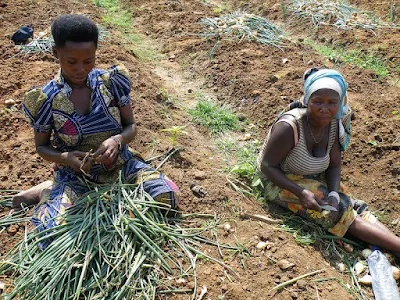33 Things Burundi is known for
Learn 33 interesting facts about the African country of Burundi including her geography, history, climate, people, and government.
It is important to see beyond what a tourist usually sees and understand Burundi culture, economy, and her people. Make an effort to learn as much about Africa and Burundi as you can learn an African country a day to demonstrate your willingness to learn as well as a respect for the culture.
33 things Burundi is known for
Facts about Burundi Africa You Need to Know.1. Burundi goes by three names; her official name is the Republic of Burundi, short name Burundi and her local name is Republique y'u Burundi.
2. Former name of Burundi was Urundi derived from the pre-colonial Kingdom of Burundi in the 17th-19th centuries.
3. Burundi is the most population-dense country in Africa. There is an average of 248 people per square mile and the population is growing rapidly at nearly 3% each year.

|
| Batwa Woman Prepping Clay to Make Pots in Murwi, Burundi |
4. Burundi is a landlocked country in the African Great Lakes region of East Africa, bordered by Rwanda to the north, Tanzania to the east and south, and the Democratic Republic of the Congo to the west.
5. Burundi’s capital is Bujumbura with a population of 751,000 that is slightly larger than the total the population of North Dakota.
6. Burundi’s total the population is 10.7 million (2015 World Bank).
7. There is no citizenship by birth, citizenship is by descent only, and the father must be a citizen of Burundi.

|
| Smiling baby boy in Murwi, Burundi |
8. The national symbol is a lion.
9. Burundi’s national colors are red, white, and green.
10. In Burundi 45.64% of the population is age 0-14 years, the average age for males is 17 years and females 16.8 years old.
11. Kirundi spoken by 29.7% is an official language along with French spoken by 0.3%, nearly 56.9% of Burundi’s languages are not classified.
12. Ethnic groups in Burundi are Hutu (Bantu) 85%, Tutsi (Hamitic) 14%, Twa (Pygmy) 1%, Europeans 3,000, South Asians 2,000
13. Religions Catholic 62.1%, Protestant 23.9%, Muslim 2.5%, other 3.6%, unspecified 7.9% (2008 World Bank).

|
| Visually impaired men in Burundi |
14. Burundi and Rwanda dispute two sq km (0.8 sq mi) of Sabanerwa, a farmed area in the Rukurazi Valley where the Akanyaru/Kanyaru River shifted its course southward after heavy rains in 1965.
15. The size of Burundi is 27,816 sq km area slightly smaller than Maryland.
16. Its lowest point is Lake Tanganyika 772 m, the highest point is Mount Heha 2,670 m.
17. Burundi has two wet seasons from February to May and September to November, and two dry seasons from June to August and December to January.
18. Agriculture accounts for over 40% of GDP and employs more than 90% of the population in Burundi.
19. Burundi's primary exports are coffee and tea, which account for 90% of foreign exchange earnings.

|
| Curing onions after harvest in Bujumbura, Burundi |
20. Foreign aid in 2014 represented 42% of Burundi's national income, the second highest rate in Sub-Saharan Africa.
21. Burundi’s Independence Day is July 1, 1962, from UN trusteeship under Belgian administration.
22. Burundi’s type of government is a presidential republic.
23. Burundi has been plagued by ongoing civil war for the past 15 years.
24. More than 200,000 Burundians perished during the conflict that spanned almost a dozen years.
25. Burundi's first democratically elected president was assassinated in October 1993 after only 100 days in office.
26. Pierre Nkurunziza, a former Hutu rebel leader, became the first president to be chosen in democratic elections since the start of Burundi's civil war in 1994. After 15 years in power, Pierre Nkurunziza was also due to receive a $540,000 or £440,000 retirement pay-out and a luxury villa however he died June 8, 2020 of cardiac arrest after efforts to revive him were unsuccessful. The government has announced seven days of national mourning. According to the constitution, if the head of state dies in office then the president of the national assembly, currently Pascal Nyabenda, should succeed him. The winner of May's presidential election, Evariste Ndayishimiye, is due to be sworn in as president in August.

|
| Road between Burundi Gitega and Bujumbura |
27. The government of Burundi still faces heavily disputed elections and continues to face many political and economic challenges.
28. Burundi’s legal system is a mixed legal system of Belgian civil law and customary law.
29. Burundi is one of the red zone countries identified as being among the most affected by soaring food prices throughout the world.
30. Burundi, like much of Central Africa, is also prone to natural disasters. Floods, hailstorms, drought and torrential rain are recurrent in Burundi.

|
| Burundi national football team Intamba m’Urugamba |
31. The four most popular sports in Burundi are football (soccer) basketball, track and field, judo and rugby.
32. The Burundi national football (soccer) teams Intamba m’Urugamba are nicknamed Les Hirondelles dans la guerre or The Swallows in the War.
33. Urubugu or mancala is an ancient ball and pit board game popular among Burundians of all ages.
Together we build awareness that boost harmony, education, and success, below are more links to articles you will find thought provoking.
- African Country Names Your Saying Wrong
- What do Waist Beads Symbolize in Africa?
- About African Healers and Witchdoctors
- Hurricanes are Angry African Ancestors
- Highest Temperature and Lowest Temperature in Africa
- About African Night Running


